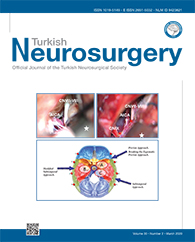2Trakya University School of Medicine, Department of Medical Biology, Edirne, Turkey
3Trakya University School of Medicine, Department of Histology and Embryology, Edirne, Turkey DOI : 10.5137/1019-5149.JTN.26122-19.1 AIM: To determine the interaction between ruxolitinib, JAK/STAT signalling, and two angio-microRNAs (miRs) to expose potential target molecules in the inhibition of glioblastoma invasion.
MATERIAL and METHODS: The invasion properties of glioblastoma were analyzed using a cancer cell spheroid invasion assay. Following treatment of 195 nM ruxolitinib, the relative expression levels of miR-17 and miR-20a and genes of IL-6/JAK/STAT3 receptor signaling belonging to the JAK/STAT pathway were measured by qRT-PCR in treated and untreated three-dimensional tumor spheres of U87 cells.
RESULTS: Our results indicated that a therapeutic dose of ruxolitinib (195 nM) significantly increased miR-17 and miR-20a expression. Ruxolitinib treatment resulted in the production of IL-6 and active formation of IL-6 receptor complex for the subsequent activation of the IL-6R/JAK2/STAT3 axis. However, ruxolitinib treatment significantly decreased the expression of JAK2 and PI3K. Pearson correlation analyses revealed a strong negative correlation of miR-17 with JAK2, STAT3, and PI3K expressions, and also miR-20a has a negative correlation with expression levels of JAK2 and PI3K. The only positive correlation was found to be between miR-20a and IL-6, gp130 expressions.
CONCLUSION: The specific JAK2 inhibitor ruxolitinib plays an important role in glioblastoma angiogenesis biology via inhibiting IL-6 receptor-dependent JAK/STAT signaling. Additionally, both miR-17a-3p and miR-20a overexpression induced by ruxolitinib treatment may be playing a major role in downregulated JAK2, STAT3, and PI3K proteins. Our results suggest that miR-17-3p and miR-20a-5p may serve as new therapeutic targets for the treatment of glioblastoma.
Keywords : Angiogenesis inhibitors, Drug effects, Glioblastoma, Invasion, Ruxolitinib, JAK/STAT signaling pathway, microRNAs, Molecular targeted therapy




